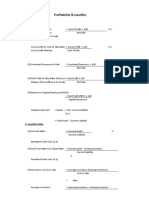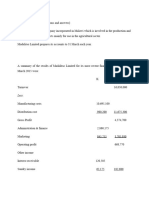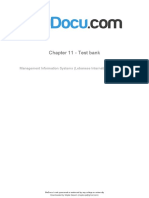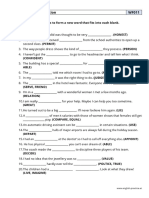Case 5-32&33
Case 5-32&33
Uploaded by
Majde QasemCopyright:
Available Formats
Case 5-32&33
Case 5-32&33
Uploaded by
Majde QasemOriginal Description:
Original Title
Copyright
Available Formats
Share this document
Did you find this document useful?
Is this content inappropriate?
Copyright:
Available Formats
Case 5-32&33
Case 5-32&33
Uploaded by
Majde QasemCopyright:
Available Formats
Majde Qasem (120192712) CASE 5–32&33
1- The overall break-even sales can be determined using
the CM ratio.
Velcro Metal Nylon Total
Sales 165000 $ 300000 $ 340000 $ 805000 $
Variable expenses 125000 $ 140000 $ 100000 $ 365000 $
Contribution Margin
Fixed expenses 400000
Net operating income 40000 $
CM ratio = Contribution margin \ Sales
= 440000 $ \ 805000 $
= 0.5466
Dollar sales to break-even = Fixed expenses \ CM ratio
= 400000 $ \ 0.5466
= 732000 $ ( rounded )
2- The issue is what to do with the common fixed cost when
computing the break-even for the individual products .
The correct approach is to ignore the common fixed costs.
If the common fixed costs are included in computations ,
the break-even points will be overstated for individual
products and managers may drop products in fact are
profitable.
Majde Qasem (120192712) CASE 5–32&33
a. The break-even points can be computed using the
contribution margin approach as follows :
Velcro Metal Nylon
Unit selling price 1.65 $ 1.50 $ 0.85 $
Variable cost per unit 1.25 0.70 $ 0.25 $
Unit contribution margin (a) 0.40 $ 0.80 $ 0.60 $
Product fixed expenses (b) 20000 $ 80000 $ 60000 $
Unit sales to break even (b)\(a) 50000 100000 10000
b.
Velcro Metal Nylon Total
Unit Sales 50000 100000 100000
Sales 82500 $ 150000 $ 85000 $ 317500 $
Variable expenses 62500 70000 25000 157500
Contribution margin 20000 $ 80000 $ 60000 $ 160000
Fixed expenses 40000 $
Net operating loss 240000 $
hence, the overall loss of the company is 240000$
In the case the company sales the break-even quantity of each
product, each product will show zero segments net income and
the common fixed expense will remain as a net operating loss
Majde Qasem (120192712) CASE 5–32&33
15% commission 15% commission Own Sales Force
Sales 16000 $ 100% 16000$ 100% 160000$ 100%
Variable expenses
Manufacturing 7200 7200 720000
Commission 2400 3200 120000
Total variable expenses 9600 60% 10400 65% 840000 52.5%
Contribution margin 6400 40% 5600 35% 760000 47.5%
Fixed expenses
Manufacturing overhead 2340 2340 234000
Marketing 120 120 252000**
Administrative 1800 1800 172500***
Interest 540 540 54000
Total fixed expenses 4800 4800 712500
Income before income 1600 800 47500
taxes
Income taxes(30%) 480 240 14250
Net income 1120$ 560$ 332.50$
** 120000$ + 2400000$ = 2520000$
***1800000$ - 75000$ = 1725000$
1. When the income before taxes is zero, income taxes will also be zero and net
income will be zero. Therefore, the break-even calculations can be based on the
income before taxes.
a. Break-even point in dollar sales if the commission remains 15%
Dollar sales to break-even = fixed expenses \ CM ratio
= 4800000$ \ 0.40
= 12000000$
b. Break-even point in dollar sales if the commission remains 20%
Dollar sales to break-even = fixed expenses \ CM ratio
= 4800000$ \ 0.35
= 13714286$
c. Break-even point in dollar sales if the company employs its own sales force
Dollar sales to break-even = fixed expenses \ CM ratio
= 7125000$ \ 0.475
= 15000000$
2. In order to generate a 1120000$ net income, the company must generate
1600000$ in income before taxes. Therefore
Dollar sales to attain target = target income before taxes + fixed expenses \ CM ratio
= 1600000$ + 4800000$ \ 0.35
= 6400000$ \ 0.35 = 18285741$
Majde Qasem (120192712) CASE 5–32&33
3. To determine volume of sales at which net income would be equal under either the
20% commission plan or the company sales force plan, we find the volume of sales
where costs before income taxes under the two plans are equal
X = Total sales revenue
0.65X +4800000$ = 0.525X + 7125000$
0.125X = 2325000$
X = 2325000$ \ 0.125
X = 18600000$
Thus, at a sales level of 18600000$ either plan would yield the some income before
taxes and net income. Below this sales level, the commission plan would yield the
largest net income: above this sales level, the sales force plan yiled the largest net
income.
4. A,B and C
15% 20% Own
Commission Commission Sales Force
Contribution margin (a) 6400000$ 5600000$ 7600000$
Income before taxes (b) 1600000$ 800000$ 475000$
Degree of operating leverage 4 7 16
(a)\(b)
5. We would continue to use the sales agents for at least one more year, and possibly
for two more years. The reasons are as follows:
First, use of the sales agents would have a less dramatic effect on net income.
Second, use of the sales agents for at least one more year would give the company
more time to hire competent people and get the sales group organized.
Third, the sales force plan doesn’t become more desirable than the use of sales
agents until the company reaches sales of 1860000$ a year. This level probably
won't be reached for at least one more year, and possibly two years.
Fourth, the sales force plan will be highly leveraged since it will increase fixed costs
and decrease variable costs. One or two years from now, when sales have reached
the 18600000 level, the company can benefit greatly from this leverage. For the
moment, profits will be greater and risk will be less by staying with the agents, even
at the higher 20% commission rate.
You might also like
- ACCT 7004 Exam F2022 TemplateDocument17 pagesACCT 7004 Exam F2022 TemplateJesse DanielsNo ratings yet
- F-404 Question 1Document2 pagesF-404 Question 1MINSAFE Fin-26thNo ratings yet
- FAB The Coming Revolution On Your Desktop - From Personal Computers To Personal Fabrication by Neil GershenfeldDocument307 pagesFAB The Coming Revolution On Your Desktop - From Personal Computers To Personal Fabrication by Neil GershenfeldViviane100% (1)
- Packer and ScottDocument2 pagesPacker and ScottKiri chrisNo ratings yet
- NOMAKHOSI by Keabetswe MahlabaDocument1,580 pagesNOMAKHOSI by Keabetswe MahlabaMargaret Jobe100% (2)
- Practice Problems - Decision AnalysisDocument3 pagesPractice Problems - Decision AnalysisasaqNo ratings yet
- Group 2 - Answers To QuestionsDocument2 pagesGroup 2 - Answers To QuestionsJr Roque100% (4)
- FM Aaj KaDocument15 pagesFM Aaj Kakaranzen50% (2)
- Define The Terms Fixed Cost and Variable CostDocument2 pagesDefine The Terms Fixed Cost and Variable CostSapkota ArjunNo ratings yet
- FIN 4453 Project 3 Capital Budgeting Analysis TemplateDocument34 pagesFIN 4453 Project 3 Capital Budgeting Analysis TemplatevalNo ratings yet
- CourseUpdates - 4.3Document8 pagesCourseUpdates - 4.3Afrin KhanNo ratings yet
- JARRETT M6-2 Budget Form - Project.Document2 pagesJARRETT M6-2 Budget Form - Project.evans kirimi100% (1)
- Ch02 P20 Build A Model SolutionDocument6 pagesCh02 P20 Build A Model Solutionsonam agrawalNo ratings yet
- Chapter 23 Homework Mastery Problem Evaluating Decentralized OperationsDocument7 pagesChapter 23 Homework Mastery Problem Evaluating Decentralized OperationsBhartendu goyalNo ratings yet
- Week 3 SolutionDocument5 pagesWeek 3 SolutionI190006 Taimoor JanNo ratings yet
- Problem 1.6Document1 pageProblem 1.6SamerNo ratings yet
- Capital+budgeting SolvedDocument22 pagesCapital+budgeting SolvedutamiNo ratings yet
- Chapter 13. CH 13-11 Build A Model: (Par Plus PIC)Document7 pagesChapter 13. CH 13-11 Build A Model: (Par Plus PIC)AmmarNo ratings yet
- Question4 Solved With GraphDocument8 pagesQuestion4 Solved With GraphShafiqUr RehmanNo ratings yet
- Chapter 15 SolutionsDocument6 pagesChapter 15 SolutionshappysparkyNo ratings yet
- Case 20: The Walt Disney Company: Strategic ManagementDocument31 pagesCase 20: The Walt Disney Company: Strategic ManagementAYU SINAGANo ratings yet
- 'Diamond Chemicals PLC (A) ' Exhibit 2Document1 page'Diamond Chemicals PLC (A) ' Exhibit 2hayagreevan vNo ratings yet
- Hankuk Electronics Started Production On A Sophisticated New Smartphone Running The Android Operating System in January 2017Document3 pagesHankuk Electronics Started Production On A Sophisticated New Smartphone Running The Android Operating System in January 2017Elliot RichardNo ratings yet
- 4-35 Model ProblemDocument18 pages4-35 Model Problemcherishwisdom_997598100% (1)
- Chapter 14 Test BankDocument31 pagesChapter 14 Test BankMajde QasemNo ratings yet
- ABC CostingDocument17 pagesABC CostingnehaNo ratings yet
- Bac 3 Review QNSDocument16 pagesBac 3 Review QNSsaidkhatib368No ratings yet
- Chapter 4 - Build A Model SpreadsheetDocument9 pagesChapter 4 - Build A Model SpreadsheetSerge Olivier Atchu Yudom100% (1)
- ACC10007 Sample Exam 2 - SolutionDocument10 pagesACC10007 Sample Exam 2 - SolutiondannielNo ratings yet
- 6int 2006 Dec QDocument9 pages6int 2006 Dec Qrizwan789No ratings yet
- Answer Key To Test #3 - ACCT-312 - Fall 2019Document8 pagesAnswer Key To Test #3 - ACCT-312 - Fall 2019Amir ContrerasNo ratings yet
- Marketing by The Numbers: Apple vs. MicrosoftDocument2 pagesMarketing by The Numbers: Apple vs. MicrosoftXuan XuanNo ratings yet
- Assignment 2Document12 pagesAssignment 2harnarinenaraindattNo ratings yet
- Bài Tập 2-27 - Nhóm8LớpKN007Document6 pagesBài Tập 2-27 - Nhóm8LớpKN007nguyenhongNo ratings yet
- Input For Financial Drivers WorksheetDocument2 pagesInput For Financial Drivers WorksheetYakraj SharmaNo ratings yet
- PROBLEMS in ForexDocument2 pagesPROBLEMS in ForexPrethivi RajNo ratings yet
- 05 Wilkerson Company Solution - StudentsDocument9 pages05 Wilkerson Company Solution - StudentsVinyabhooshan Bajpai PGP 2022-24 Batch100% (1)
- Brewer8e GEs PPT Chapter 8 UpdDocument22 pagesBrewer8e GEs PPT Chapter 8 UpdNguyễn Ngọc Quỳnh TiênNo ratings yet
- Decision MakingDocument8 pagesDecision MakingkhandakeralihossainNo ratings yet
- Xytech IncDocument12 pagesXytech IncApoorv SinghalNo ratings yet
- Advanced Accounting Ch3 Cost MethodDocument3 pagesAdvanced Accounting Ch3 Cost MethodFiona TaNo ratings yet
- Assignment 1faefDocument2 pagesAssignment 1faefSri Ram50% (2)
- ACC10007 Sample Exam 2Document9 pagesACC10007 Sample Exam 2dannielNo ratings yet
- Break Even Point in Unit Sales Dollar SalesDocument27 pagesBreak Even Point in Unit Sales Dollar SalesdrgNo ratings yet
- Management Accounting - 2: Project Report By-Group - A4Document11 pagesManagement Accounting - 2: Project Report By-Group - A4ANSHIKA SINGHNo ratings yet
- Dilbert Laboratories LimitedDocument6 pagesDilbert Laboratories Limitedlarevir.riveralNo ratings yet
- Maria HernandezDocument8 pagesMaria HernandezAimane BeggarNo ratings yet
- Bca 423-Marginal Vs Absoption Costing.Document8 pagesBca 423-Marginal Vs Absoption Costing.James GathaiyaNo ratings yet
- 3 Model Q. Set A BBS 2nd Year Cost and Management - AccountingDocument5 pages3 Model Q. Set A BBS 2nd Year Cost and Management - Accountingprabeshchaudhary3No ratings yet
- ABC Text BookDocument115 pagesABC Text BookNaing linnNo ratings yet
- Rappa CaseDocument2 pagesRappa Casegusti dianNo ratings yet
- Mirri TaxDocument10 pagesMirri TaxMandanda LovemoreNo ratings yet
- Chicago Valve TemplateDocument5 pagesChicago Valve TemplatelittlemissjaceyNo ratings yet
- As The Capital Budgeting Director of Union Mills Inc.-Dcf ANALYSIS-DISCOUNTED CASH FLOWDocument1 pageAs The Capital Budgeting Director of Union Mills Inc.-Dcf ANALYSIS-DISCOUNTED CASH FLOWRajib Dahal100% (1)
- Solution To Trina Haldane - Question 4Document2 pagesSolution To Trina Haldane - Question 4Debbie Debz100% (2)
- Kookuburra Cricket Bats Excel SheetDocument4 pagesKookuburra Cricket Bats Excel SheetChakri MunagalaNo ratings yet
- Evaluacion Salud FinancieraDocument17 pagesEvaluacion Salud FinancieraWilliam VicuñaNo ratings yet
- Final TaxDocument5 pagesFinal TaxHuy HudsonNo ratings yet
- hw01p0091n06 JMKDocument3 pageshw01p0091n06 JMKakash1pardeshiNo ratings yet
- Group # Name:: 3 Lucy VanDocument16 pagesGroup # Name:: 3 Lucy VanNgoc Tram VanNo ratings yet
- Assume The FollowingDocument3 pagesAssume The FollowingElliot RichardNo ratings yet
- Marginal AbsorptionDocument4 pagesMarginal Absorptionbalachmalik100% (1)
- CASE 5-33 Solution: Nabeeda ShaheenDocument4 pagesCASE 5-33 Solution: Nabeeda ShaheenhadiNo ratings yet
- Chapter 11 Test BankDocument30 pagesChapter 11 Test BankMajde QasemNo ratings yet
- Chapter 6 - Test Bank Chapter 6 - Test BankDocument28 pagesChapter 6 - Test Bank Chapter 6 - Test BankMajde QasemNo ratings yet
- Chapter 10 Test BankDocument29 pagesChapter 10 Test BankMajde Qasem100% (1)
- Case Page 491Document5 pagesCase Page 491Majde QasemNo ratings yet
- The Islamic University of Gaza Faculty of Economics & Administrative Sciences Management Information SystemsDocument8 pagesThe Islamic University of Gaza Faculty of Economics & Administrative Sciences Management Information SystemsMajde QasemNo ratings yet
- Feature WritingDocument54 pagesFeature WritingShyra Jane AbonallaNo ratings yet
- Class 12 Accounts Pre-Board CorrectDocument7 pagesClass 12 Accounts Pre-Board CorrectHarini NarayananNo ratings yet
- I410 Ecn 0199 2022 001 000168432Document13 pagesI410 Ecn 0199 2022 001 000168432kwym31No ratings yet
- Paper PDFDocument19 pagesPaper PDFrajeshNo ratings yet
- Commercial Dispatch Eedition 8-26-19Document12 pagesCommercial Dispatch Eedition 8-26-19The DispatchNo ratings yet
- Top 6 Natural Growth Hormone BoostersDocument9 pagesTop 6 Natural Growth Hormone Boosterssuman59No ratings yet
- Tobii Pro Glasses 3: Designed For The Real WorldDocument3 pagesTobii Pro Glasses 3: Designed For The Real WorldDhanush sridharNo ratings yet
- Role of Nepali Army in Promotion and Preservation of Nepalese Art, Culture, and TraditionsDocument15 pagesRole of Nepali Army in Promotion and Preservation of Nepalese Art, Culture, and TraditionsAvash ShresthaNo ratings yet
- Soal Ujian Semstr Ganjil 2017-2018Document19 pagesSoal Ujian Semstr Ganjil 2017-2018Afriadi A. PalasongNo ratings yet
- Scottish Leadership Qualities Framework - Guidance Notes July 2014Document18 pagesScottish Leadership Qualities Framework - Guidance Notes July 2014Praveena SymeonoglouNo ratings yet
- How To Pass in University Arrear Exams?Document26 pagesHow To Pass in University Arrear Exams?arrearexam100% (6)
- Basics of Enterprise Application Integration For DummiesDocument8 pagesBasics of Enterprise Application Integration For DummiesReddappa Gowd75% (4)
- Purushartha SDocument291 pagesPurushartha SjunkyardNo ratings yet
- GHCDC MAD SCI Engeneers ReportDocument117 pagesGHCDC MAD SCI Engeneers ReportGGHMADNo ratings yet
- The Lost WordsDocument12 pagesThe Lost WordszoiberNo ratings yet
- Samsara and NirvanaDocument5 pagesSamsara and NirvanaMarya Fanta C LupuNo ratings yet
- Economics Today The Micro 17th Edition Roger LeRoy Miller Test Bank DownloadDocument136 pagesEconomics Today The Micro 17th Edition Roger LeRoy Miller Test Bank DownloadGladys Carr100% (31)
- The Photo Poem Project 2Document4 pagesThe Photo Poem Project 2api-264656588No ratings yet
- Hindustan TimesDocument46 pagesHindustan TimesthakursukritiNo ratings yet
- Case Study QuestionsDocument3 pagesCase Study QuestionsabbienkangaNo ratings yet
- Jesus Christ The Son of Mary: and His Most Blessed MotherDocument36 pagesJesus Christ The Son of Mary: and His Most Blessed MotherTyba314No ratings yet
- Homosexuality in Church and State - Mapping The IssuesDocument78 pagesHomosexuality in Church and State - Mapping The IssuesPaul Christopher James BurgessNo ratings yet
- Anti-Red Tape Act of 2007 - RA 9485Document5 pagesAnti-Red Tape Act of 2007 - RA 9485Rudy OrteaNo ratings yet
- 10 - Relative Clauses - PracticeDocument2 pages10 - Relative Clauses - PracticeSantosNo ratings yet
- Wf011 Word FormationDocument2 pagesWf011 Word FormationbachmasonNo ratings yet
- Salon Reservation SystemDocument9 pagesSalon Reservation SystemAdrian Kenneth Dequiña TandiamaNo ratings yet
- Downfall of ORKUTDocument15 pagesDownfall of ORKUTPriya Ahuja100% (1)
- HALIFX PUBLIC LIBRARY ProjectDocument20 pagesHALIFX PUBLIC LIBRARY ProjectAhmadNo ratings yet































































































